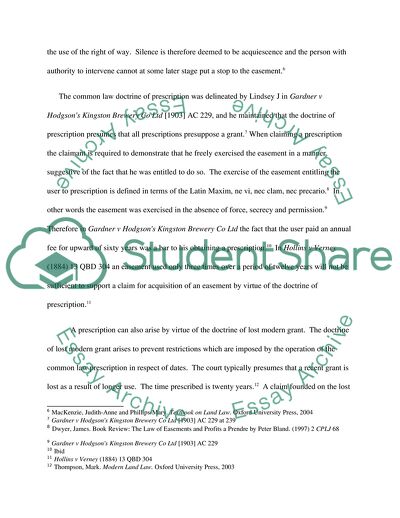
- Home
- Free Samples
- Premium Essays
- Editing Services
- Extra Tools
- Essay Writing Help
- About Us
- Studentshare
- Subjects
- Miscellaneous
- Land Law - Easements (Prescription Act 1832)
Land Law - Easements (Prescription Act 1832) - Essay Example

- Subject: Miscellaneous
- Type: Essay
- Level: Undergraduate
- Pages: 4 (1000 words)
- Downloads: 0
- Author: nwisozk
Extract of sample "Land Law - Easements (Prescription Act 1832)"
4 However the purchase is required to by deed and easements will run with the land unless the conveyance to a purchaser specifically provides otherwise. 5 A prescription can arise by virtue of presumption in the case of a continued and uninterrupted use of a right of way. The presumption arises when a right of way is exercised and the person who has authority to put a stop to the exercises of a right of way does nothing to interfere with the use of the right of way. Silence is therefore deemed to be acquiescence and the person with authority to intervene cannot at some later stage put a stop to the easement.
6 The common law doctrine of prescription was delineated by Lindsey J in Gardner v Hodgsons Kingston Brewery Co Ltd [1903] AC 229, and he maintained that the doctrine of prescription presumes that all prescriptions presuppose a grant.7 When claiming a prescription the claimant is required to demonstrate that he freely exercised the easement in a manner suggestive of the fact that he was entitled to do so. The exercise of the easement entitling the user to prescription is defined in terms of the Latin Maxim, ne vi, nec clam, nec precario.
8 In other words the easement was exercised in the absence of force, secrecy and permission.9 Therefore in Gardner v Hodgsons Kingston Brewery Co Ltd the fact that the user paid an annual fee for upward of sixty years was a bar to his obtaining a prescription.10 In Hollins v Verney (1884) 13 QBD 304 an easement used only three times over a period of twelve years will not be sufficient to support a claim for acquisition of an easement by virtue of the doctrine of prescription.11 A prescription can also arise by virtue of the doctrine of lost modern grant.
The doctrine of lost modern grant arises to prevent restrictions which are imposed by the operation of the common law prescription in respect of dates. The court typically presumes that a
...Download file to see next pages Read MoreCHECK THESE SAMPLES OF Land Law - Easements (Prescription Act 1832)
Land Law: Adelaide
The Law on Easements
Land Law: The Legal Advice
Land Registration Act 2002
The Prescription Act of 1832
Easement Law Issues
Analysis of Property Law Cases
The Current Law in England and Wales, Its Deficiencies and the Future

- TERMS & CONDITIONS
- PRIVACY POLICY
- COOKIES POLICY